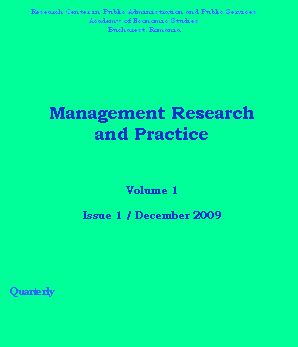
BUSINESS EXCELLENCE AND MANAGEMENT
ISSN
2248-1354 (print)
2668-9219 (online)
ISSN-L: 2248- 1354
|
Home |
|
| Journal description | |
| Aims and scope | |
| Publication ethics | |
| Indexation | |
| Editorial information | |
| Editorial team | |
| Editorial Board | |
|
Journal content |
|
| Current issue | |
| Previous issues | |
| Special issues | |
| Guideline for authors | |
| Submission | |
| Manuscript style | BEMAN Template |
|
|
| Volume 8, Issue 3, September 2018 |
|
1. THE IMPACT OF RECRUITMENT AND SELECTION IN NIGERIA
Edwin ANYIM Nigeria
Mirabel NWOSU Nigeria
|
|
The research is focused on the importance recruitment plays in Nigeria as well as Selection in getting the right Candidates. Care must be taken to ensure that only prospective candidates who are qualified to get employed in an organization. The prospective job seeker should have the right skills ad qualification and also possess good character and clean record. If an error is made at this stage, by way of bringing in a bad character, it could cause danger for the organization because, as the English people would say: “one bad apple can spoil the whole bunch”. Recruitment could be seen as the process of finding and hiring candidates for a job opening while Selection is the process of choosing from a pull of candidates the one that fit the best within the organization. The data gathered were analyzed using frequency and percentages. The hypothesis formulated for the study was tested using chi-square method to arrive at the research result. Findings revealed at the research result. Findings revealed that an organization must have good recruitment and selection policies and procedure in place in order to attract qualified employees... |
|
2. A SYSTEMATIC REVIEW OF THE INTERNAL AND EXTERNAL BARRIERS TO PUBLIC SECTOR INNOVATION IN KOSOVO
Rinor KURTESHI
Kosovo |
|
The focus of this study is to identify the barriers to innovation processes in the public sector of Kosovo. This study is exploratory and a mixed methodology is used, while the findings are compared and contrasted with the most recent literature in public sector innovation. The findings clearly indicate that a risk-averse culture still persists in Kosovo’s public sector. In addition to that, lack of human and financial resources add another important barrier towards public sector innovation. Moreover, staff resistance is also considered an important barrier to public sector innovation in Kosovo. Therefore, it is recommended for public sector managers to integrate the new concepts of open innovation and networked governance to diminish these barriers. These concepts demand engaging all employees as well as external parties in critical innovation processes which in default will lead to the adoption of a culture of innovation in the public sector of Kosovo. This study contributes to further research, regarding the adoption of a culture of innovation in the public sector of developing countries. Lastly, this research enriches and extends the current knowledge of public sector innovation with focus on the barriers to public sector innovation processes in developing countries... |
|
3. INNOVATION IN ROMANIAN ORGANIZATIONS. A GAP ANALYSIS AT REGIONAL LEVEL
Ștefan Cătălin POPA The Bucharest University of Economic Studies, Bucharest Romania Cezar-Petre SIMION The Bucharest University of Economic Studies, Bucharest Romania Simona Cătălina ȘTEFAN The Bucharest University of Economic Studies, Bucharest Romania Cătălina Florentina ALBU The Bucharest University of Economic Studies, Bucharest Romania
|
|
This article presents the results of a gap analysis conducted at the level of Romania's development regions regarding innovation in organizations. The research was focused on determining the gap in Regional Innovation Scoreboard (RIS) between Romania's development regions and the EU average as well as analyzing gap dynamics in 2009-2017. The results obtained from the research seem to indicate that: the gap existing at the beginning of the analyzed period had a downward dynamics and it was accentuated for all the development regions of Romania; the quasimajority of the regions of Romania registers modest values of RIS compared to the EU average, which places them on the last places in the EU; some regions of Romania are very close to the EU average in some RIS-specific indicators such as the Bucharest-Ilfov region for trademark applications and for other indicators the gaps are very high; the innovation of Romanian organizations is focused on technical aspects. The existing disparities and the tendency of their accentuation largely explain the relatively small competitiveness of Romanian organizations in the single market and the effort to be made to recover them... |
Other ASE journals


